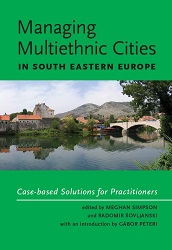Local Cooperation in the South Adriatic Region
Local Cooperation in the South Adriatic Region
Author(s): Živorad Kovačević
Subject(s): Politics / Political Sciences, Politics, Civil Society, Governance, International relations/trade, Inter-Ethnic Relations, Geopolitics
Published by: Centar za regionalizam
Keywords: South Adriatic region; triangle of cooperation; regional cooperation
Summary/Abstract: The South Adriatic region exemplifies the difficulties that national and local governments and local communities have faced in overcoming the effects of the dissolution of Yugoslavia and the violence that characterized much of the 1990s. This chapter presents the initiative to establish a triangle of cooperation among the neighboring cities of Dubrovnik in southern Croatia, Trebinje in Bosnia and Herzegovina, and Herceg Novi in Montenegro. The region in which these cities are located is one that is ethnically or denominationally diverse. However, the cities in these regions share not only a recent past, but also common infrastructure, public services, and natural resources. New borders since the dissolution of Yugoslavia have created immense obstacles for local populations, in terms of visiting relatives, traveling to work, accessing schools and employment, and managing shared resources like water. While Dubrovnik, Trebinje, and Herceg Novi differ in numerous ways, such as in terms of economic indicators and their population size, they continue to be interdependent. For local governments, the effective management of issues like water management, tourism, waste disposal and fire protection depended upon intermunicipal agreement. In 2001, at its fourth session held in Dubrovnik in October, the Igman Initiative, launched an effort to establish a new triangle of cooperation among these cities. The idea was to rebuild cooperation among local authorities, enterprises, and communities that continued to suffer as a result of the recent was in their region. While there was interest and demand in these cities to cooperate, their particular set of challenges surpassed the capacities of local government and NGOs. Cooperation in the region has necessitated the role of central governments. That is, one particularly important aspect of intermunicipal cooperation in this interconnected region was the need to work with central governments on issues like responding to fires and managing scare water resources. The Center for Regionalism, the Igman Initiative, and Philia have played a pivotal role in improving intermunicipal cooperation in this region.
Book: Managing Multiethnic Cities in South Eastern Europe - Case-based Solutions for Practitioners
- Page Range: 157-182
- Page Count: 26
- Publication Year: 2010
- Language: English
- Content File-PDF

